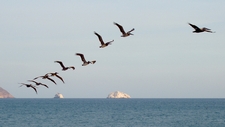Animal Migration

TEKS Objective
The student is expected to identify factors in the environment, including temperature and precipitation that affect growth and behavior such as migration, hibernation, and dormancy of living things.
Essential Understanding
The student knows that living organisms have basic needs that must be met for them to survive within their environment.
Science Background
Migration Information: National Park Service (website) - Explanation of what migration is, why animals migrate, and how they know when to leave and where to go. Describes different types of migration. Use the left navigation menu to see additional migration information and examples.
Migration Basics
National Park Service, www.nps.gov
Animal Migration: Utah Education Network (website) - General information about animal migration and links to a variety of resources for classroom activities related to migration of birds, whales, and more.
Animal Migration
Utah Education Network, www.uen.org
Migration and Tagging: Monarch Watch (website) – No other butterflies migrate like the Monarchs of North America. Learn about their annual journey here.
Migration and Tagging
Monarch Watch, University of Kansas, www.monarchwatch.org
Signature Lesson
Animal Migrations, Butterfly Buddies: SeaWorld/Busch Gardens (PDF) - Students will identify phases of butterfly life cycles and environmental factors that influence migration patterns of painted lady butterflies.
Animal Migrations, Butterfly Buddies
SeaWorld/Busch Gardens, www.swbg-animals.org
- Supporting Lessons
- Extensions
- Assessment Ideas
- Literature Connections
- Related
TEKS - Additional Resources
Supporting Lessons
When Will Our Hummingbird Habitat be Ready? Journey North (website) - Explore the chain of sun-driven events that must occur before hummingbirds can return to their breeding habitat.
When Will Our Hummingbird Habitat be Ready?
Journey North, The Annenberg Foundation, www.learner.org
In the Classroom: Monarch Watch (website) - A series of questions about monarch butterflies—including three testable questions for younger students—serve as the basis for student hypotheses, observation, and investigation. Includes background information and links to research projects and vocabulary.
In the Classroom
University of Kansas, Monarch Watch, www.monarchwatch.org
Monarch Butterfly Migration Tracking Project: Journey North (website) - Help track the monarch butterfly migration each fall and spring as the butterflies travel to and from Mexico. Students report their observations to real-time migration maps.
Elaboration Lessons and Extensions
Spring Fever: Journey North (website) - It has been said that robins arrive in an area when the average temperature is 36?F. This activity provides detailed instructions and extension ideas for investigating this hypothesis with your class.
Spring Fever
Journey North, The Annenberg Foundation, www.learner.org
Wildebeest Migration: National Geographic (website) - Students learn about wildebeest migration in eastern Africa, make maps of the route, and write stories about wildebeests and their migration.
Wildebeest Migration
National Geographic, www.nationalgeographic.com
Assessment Ideas
Assessment Strategies and Tools: Journey North (website) - Several suggested activities to assess student understanding of the relationships among animal migration, habitat and seasons.
Assessment Strategies and Tools
Journey North, The Annenberg Foundation, www.learner.org
Literature Connections
Why Do Geese Fly South in Winter? A Book about Migration. Allen, Kathy (ISBN-13: 978-0736863803)
Migration. Nelson, Robin (ISBN-13: 978-0761356820)
Great Migrations: Butterflies. Marsh, Laura (ISBN-13: 978-1426307393)
Great Migrations: Whales, Wildebeests, Butterflies, Elephants, and Other Amazing Animals on the Move. Carney, Elizabeth (ISBN-13: 978-1426307003)
Going Home: The Mystery of Animal Migration. Berkes, Marianne (ISBN-13: 978-1584691273)
Additional Resources
Monarch Butterfly Life Cycle and Migration: National Geographic Education (website) - Students watch a time-lapse video of the monarch butterfly life cycle, illustrate and label the life cycle, and research and record information about monarchs’ survival techniques and preparation for migration. Includes detailed teacher instructions and background.
Spring Hummingbird Migration: Journey North (website) - Track the migration of hummingbirds each fall and spring as these tiny migrants travel to and from their wintering grounds.
Spring Hummingbird Migration
Journey North, The Annenberg Foundation, www.learner.org
Why Animals Migrate: National Geographic Education (website) - Students discuss reasons for animal migration, watch video clips from the series, Great Migrations, organize information, and compare and contrast migratory habits of two different species. Includes detailed teacher instructions and background.
Why Animals Migrate
National Geographic Education, education.nationalgeographic.com
Animals, Migration: University of Missouri (website) - Links to sites with maps, videos, lesson plans, and other resources focused on animal migration. Learn what migration is, when and why animals migrate, what kinds of animals migrate, and how animals prepare for migration.
Animals, Migration
University of Missouri, eThemes, ethemes.missouri.edu
TEKS Navigation
Grade 2
Need Assistance?
If you need help or have a question please use the links below to help resolve your problem.

Comments